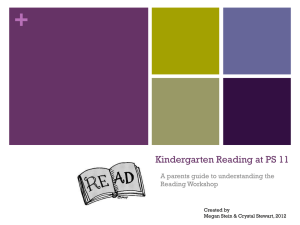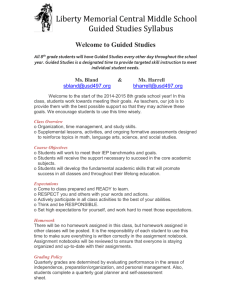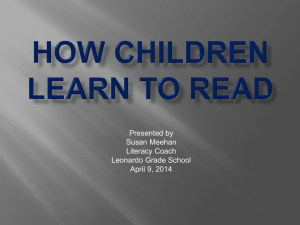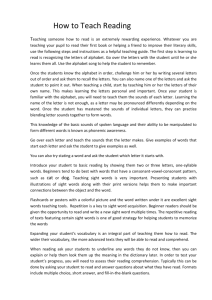Debrief the Pre-A or Early Lesson Plan
advertisement
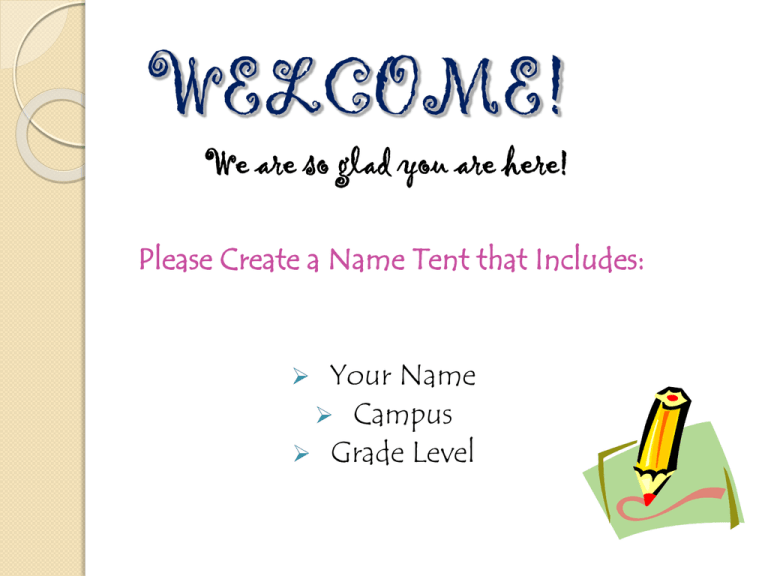
WELCOME! We are so glad you are here! Please Create a Name Tent that Includes: Your Name Campus Grade Level ELA Academy Part 2: Guided Reading for Emergent Readers Northwest ISD November 2014 Goals for Today’s Session: Debrief the Pre-A or Early Lesson plan with colleagues Examine helpful assessments for monitoring progress and grouping students Unpack the components of Emergent Lesson Plan Reflect on our own practice by watching and debriefing a model lesson Discuss scheduling, management, and progress monitoring Debrief the Pre-A or Early Lesson Plan Debrief about using the Early Lesson plan with students. What is going well? What is an area for which you would like to focus more attention? What questions do you still have? Share out with group. Guided Reading Stages Fluent N+ (30+) Early D-I (6-16) Pre-A Reader (< 40 UC & LC) *Choral Read Level A text Emergent A-C (1-4) Transitional J-M (18-28) Emergent Readers Emergent Reading Skills Letter formation Emergent Reading Strategies Employ one-to-one matching Know all letter and sounds Use meaning (picture clues) and initial letters to figure out unknown words Read and write sight words Segment sounds to write unknown words Segment sounds in sequence (CVC) Use meaning, known words, and initial letters to self-monitor during reading writing Space between words during writing Discuss a story with teach prompting Helpful Assessments for Grouping Students Dictated Sentence Writing Sample Word List Running Record Jan Richardson resources for Emergent Readers Assessment Summary Chart p. 75 Review components of Assessments chart Materials for Emergent Group(s) Alphabet linking chart (one per student) primarily to use during guided writing Letter/sound checklist (if students do not know all of their letters and sounds) Dry erase boards, markers, erasers (set of 6) 6-8 sets of lower-case magnetic letters Pictures for sound sorts (initial consonants and short medial vowels) Assessment kit Materials for Emergent Group(s) Leveled books Copies of lesson plans High frequency word chart for each group: use to record HF words students can write (pp. 81-82) Sound box templates (one per student) placed in sheet protector (p. 83) Timer – A must!!! Selecting a Text Text considerations: Story makes sense Strong picture support Mostly familiar concepts Some repetitive phrases Some familiar sight words One new sight word Watch for unfamiliar concepts/unknown words Consider type of language structures What would you take into consideration in introducing a book for a child who is finding structure tricky? Sight Word Review – Writing (about 1 minute) Goal/Purpose: To write the words quickly, build visual memory, and help control left to right visual scanning. Procedure: Teacher dictates 3 words from the leveled sight word list to see if students can write independently; Teacher tallies progress on sight word progress monitoring form 5-6 tallies/checks show student mastery Introduction of New Book 3 - 4 minutes Procedures: Teacher gives a gist statement. “This book is about...” Students talk about each page, locate sight words – predict first letter to support cross-checking, etc. Teacher supports oral language/vocab. A thorough introduction ensures student success with the text. Text Reading with Prompting (5-10 minutes) Procedures: Students are reading and rereading the book INDEPENDENTLY (no round robin reading). Teacher listens to each student briefly and uses the Prompts on the lesson plan to know what to look and prompt for each student. Encourage student independence for strategy use. … Not about accurate reading… it’s about processing!!! Take brief anecdotal notes on student behaviors. Teaching Points After Reading (1-2 minutes) Notice what strategies several students need and choose and model one or two teaching points to match needed strategies. “I want to show you something that is going to make you a better reader.” MODEL the strategies for the students. Have students BRIEFLY practice. Discussions Prompt: If appropriate, ask a question that explores deeper comprehension. Teach One Sight Word 1-2 minutes Choose one sight word (Use the same word for at least 2 days) Use ALL FOUR strategies EVERY DAY with EVERY word: ◦ ◦ ◦ ◦ What’s Missing Mix and Fix Table Writing Whiteboards Pull letters for the word AHEAD of time to save instructional time Word Study (3-5 min) Word Student options for Emergent Readers: Picture sorts Making words Sound boxes * See appendix A for example of words to use for each student activity Choose only ONE activity Specific skill for each level: Level A – hearing initial consonants Level B – hearing medial short vowels (a and o) Level C – hearing medial short vowels (i,e, and u) Prepare materials ahead of time for maximum use of time Picture Sorts Picture Sorts: (do before sound boxes) Level A - Each student gets a picture (no blends… one syllable) ◦ ◦ ◦ ◦ Level B – Each student gets 2 pictures with for initial consonant OR short medial vowel a and o (one syllable) ◦ ◦ ◦ ◦ Student says name of picture Sounds the 1st letter Names the letter Places picture under correct consonant on whiteboard Student names picture Stretches the word and “punches” the vowel sound Names the vowel Places on white board under correct letter Level C – work with all short vowels. One familiar vowel and one new vowel. Follow same procedures Making Words Procedures: Select several consonants and one vowel. Each student gets his/her own set of letters. Tell the students to make a words. ALWAYS BEGIN WITH A KNOWN WORD. Check the word by saying is slowly and running finger underneath (left to right). Skills for each level: ◦ Level A – exchange initial consonant ◦ Level B – exchange initial and final consonants ◦ Level C exchange initial, medial and final letters in a CVC word ** See examples on p. 92 Sounds Boxes Procedures: Distribute sound box templates (placed in a plastic sleeve) and if appropriate a dry erase marker. MODEL saying the word slowly and pushing counters into each box. After student can consistently push the sounds slowing segmenting, have them push the sounds and write the letter. Word Study in Action Picture Sorts Making words Sound boxes Example 1 Example 2 Guided Writing (8-10 minutes) DO NOT SKIP this component – “If you want to teach a student to read…..give him/her a PENCIL…” Procedures: Provide students with a writing journal (about 15 sheets of unlined paper stapled together). Dictate a sentence. (possibly incorporating new sight word) ◦ Level A: 3-5 words ◦ Level B: 5-7 words ◦ Level C: 7-10 words (add prepositional phrases) Differentiate for each student by rotating from student to student to address needs such as risk taking, sound boxes, letter formation, spacing, learned sight words, conventions, etc. Separate guided writing journal/notebooks just for responding to guided reading texts. (You keep at table with you after students write.) Lets watch an example of an emergent lesson Emergent Reader Lesson Debrief What was the teacher doing? What were the students doing? Noticings? Questions? Text Levels Don’t get too hung up on levels Very few students are at “that level” depends on a lot of things. Management How well do students know and practice the rituals and routines of the work period so you are able to teach guided reading with fidelity? Things to consider… -Do students know exactly where their “comfy” spot is? -Do they know and practice the expectations for independent and partner reading? -Is student stamina increasing for independent reading? -Have you explicitly modeled the expectation for Reader’s Notebook entries EVERY time students respond in their journals? -Are their many independent/easy books (6-10) in their browsing boxes to read so they are actually practicing reading? -Do you have a system in place where students know and can get help so your guided reading group is not interrupted? (crown, hat, C 3 B 4 me, etc.) Steps to Effective Guided Reading Keep groups interchangeable. Select appropriate and purposeful text. Engage in ongoing assessments. Set only one or two teaching goals for each lesson. Engage children in talking, reading and thinking. Source: Min Hong, Teaching First Grade: A Practical Guide 29 When students aren't progressing Analyze your guided reading teaching Analyze student assessments Ask a colleague to observe the student Develop an acceleration plan Involve them in guided reading every day. Provide appropriate levels of text for them to read. Have them write in connection with reading. Provide opportunities for silent reading. Provide word work based on their needs. Be sure that they spend their time reading text. Great Resources www.janrichardsonguidedreading.com Lots of resources/downloads Video demonstration lesson segments, including multiple levels of word work The Next Step in Guided Reading K8, by Jan Richardson. (Amazon.com) Continuum of Literacy Learning by Fountas & Pinnell For our Next Session…. Watch “Emergent” Lesson Video Clip. Try out the lesson plan template for a group(s) Bring a copy of one of your lesson plans and progress monitoring binder with notes and questions to debrief with colleagues. Ticket Out / Reflection Wows and Wonders On the back of your name plate, please make a T-chart list 3 Wows you are taking away today and 3 Wonders you still have Thank you for coming! Please let us know how we can help! Curriculum Department Contact information: sjohnson@nisdtx.org mvanetten@nisdtx.org pbrake@nisdtx.org



